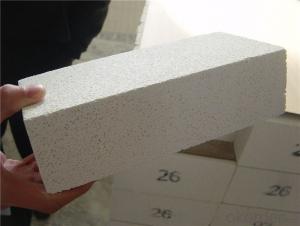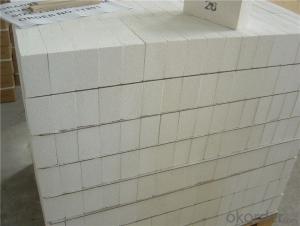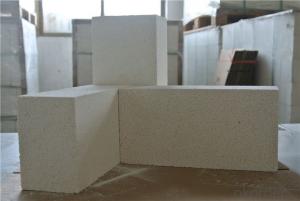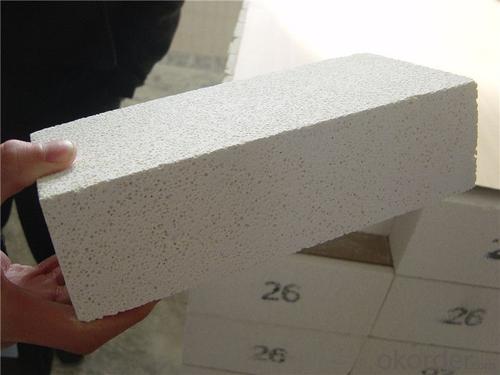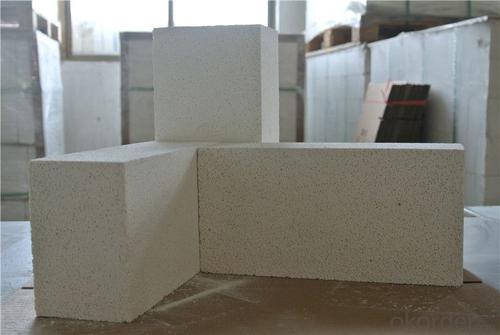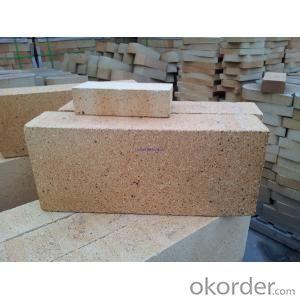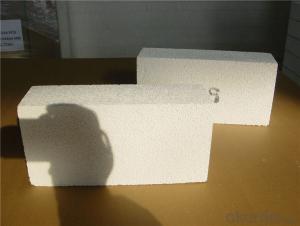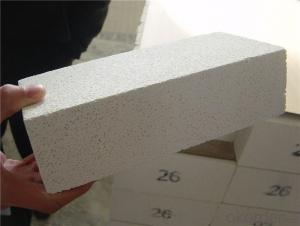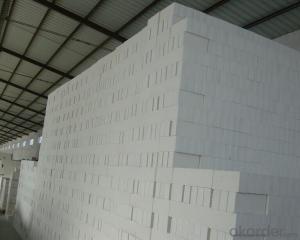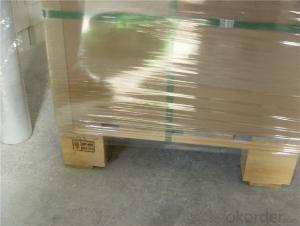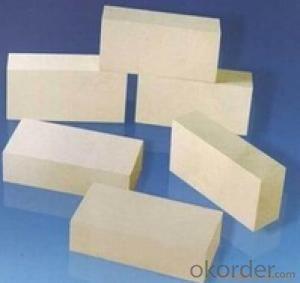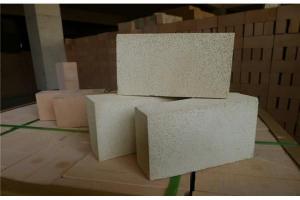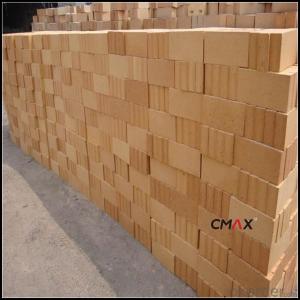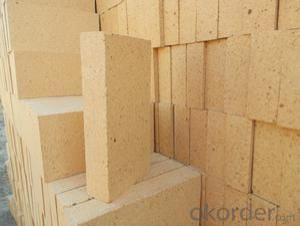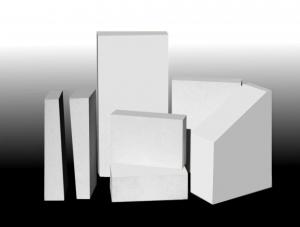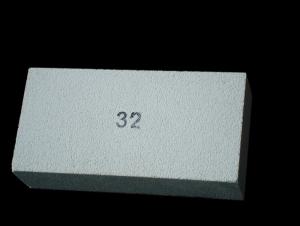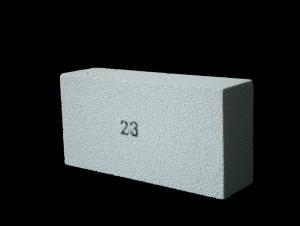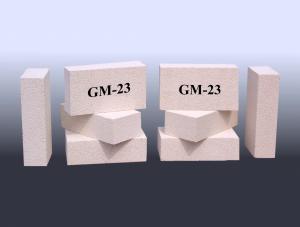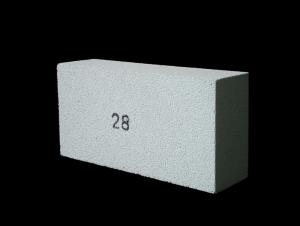Insulating Fire Brick - Lightweight Fire Clay Insulating Fire Brick
- Loading Port:
- Tianjin
- Payment Terms:
- TT OR LC
- Min Order Qty:
- 30 m.t.
- Supply Capability:
- 10000 m.t./month
OKorder Service Pledge
OKorder Financial Service
You Might Also Like
CNBM conforms strictly to the requirements of ISO 9000 quality control system during the production. MSDS is also available if you want. The thermal insulation fire clay brick meet with the requirements of ASTM & JIS standards. So pls stay cool with our quality.
Insulating Fire Brick Technical index
Product No. | IFB70 | IFB60 | IFB50 | IFB40 |
Al2O3 | 68%-72% | 58%-62% | 48%-52% | 38%-40% |
Refractoriness (°C ) | ≥1790 | ≥1790 | ≥1790 | ≥1790 |
Bulk density (g/cm3) | 2.50-2.60 | 2.35-2.45 | 2.20-2.30 | 2.10-2.20 |
Apparent porosity (%) | 22 | 19-22 | 17-20 | 17-20 |
Cold Crushing strength (kg) | 480-510 | 450-480 | 430-450 | 390-430 |
Application
Insulating Fire Brick are used for the lining of converter, alternating current arc furnace, direct Current arc furnace and the ladle slag line, etc.
Equipment
1 unit of Ceramic Abrasive (SG Abrasive) pilot production line
2 units of Compact grain Abrasive pilot production lines
1 unit of high-end coated abrasives (abrasive cloth) production line
2 units of Boron Carbide production lines
3 large flexible crushing and sieving lines for grit production lines
2 units of 2000KVA furnaces for Boron Carbide fusion
6 units of 5000KVA-10000KVA dumping type electric arc furnaces for Brown Fused Alumina fusion
Company Advantage
(1)Long Insulating Fire Brick manufacture history: 25 years manufacturer
(2)Advanced equipment
(3)Diversification of production standards: ISO ANSI FEPA JIS ASTM
(4)Flexible payment: T/T L/C D/P D/A
(5)Professional marketing team and after-sale service
(6)Free sample
FAQs
Q1 |
What’s the transport method? |
A1 | FCL delivery goods with wooden pallet or wooden case by sea; If LCL delivery, must with wooden case; Sometimes need open top, flat rack or bulk cargo. |
Q2 |
What’s the required payment term? |
A2 | Generally 30% TT as the prepayment, 70% TT before delivery. If need, 100% Irrevocable Letter of Credit or negotiation. |
Q3 |
Which country are our products exported to? |
A3 | Apart from entire Chinese market, the US, Russia, Japan, Korea, Australia and some Southeast Asian Nations. |
- Q: Do insulating fire bricks require any special curing or firing temperature profiles?
- Yes, insulating fire bricks do require special curing or firing temperature profiles. These bricks are typically made from lightweight refractory materials, which need to be slowly heated and cooled to avoid cracking or damage. The curing process involves gradually increasing the temperature over several hours and holding it at a specific level for a certain period. This allows the bricks to undergo physical and chemical changes, ensuring their optimal performance and durability in high-temperature applications.
- Q: Are insulating fire bricks suitable for use in heat exchangers?
- Depending on the specific requirements and conditions of the heat exchanger application, insulating fire bricks can be considered as a suitable option. These bricks possess exceptional thermal insulation properties, low thermal conductivity, and a remarkable ability to withstand high temperatures. As a result, they effectively minimize heat loss and conserve energy within heat exchanger systems. Moreover, insulating fire bricks are lightweight and possess good mechanical strength, allowing for convenient installation and maintenance. They are also resistant to thermal shock and chemical corrosion, guaranteeing durability and longevity even in harsh operating environments. Nevertheless, it is important to acknowledge that insulating fire bricks may not be appropriate for all heat exchanger applications. In instances where efficient heat transfer necessitates high thermal conductivity, alternative materials with greater thermal conductivity should be taken into consideration, particularly in certain industrial heat exchangers. Ultimately, the suitability of insulating fire bricks in heat exchangers relies on specific factors such as the operating conditions, design requirements, and performance expectations of the system. Therefore, it is advisable to consult experts or engineers well-versed in heat exchanger design and materials to determine the most suitable choice for a particular application.
- Q: Can insulating fire bricks be used in high-temperature insulation panels?
- Yes, insulating fire bricks can be used in high-temperature insulation panels. Insulating fire bricks are designed to withstand high temperatures and provide excellent thermal insulation. They are made from lightweight refractory materials that have low thermal conductivity, allowing them to effectively reduce heat transfer. These bricks can be used in various applications, including furnaces, kilns, and high-temperature insulation panels. They are capable of withstanding temperatures up to 3000°F (1650°C) and can effectively retain heat, making them an ideal choice for high-temperature insulation panels.
- Q: What is the price of refractory bricks?
- The refractory insulating brick generally refers to light brick, normal furnace lining are using this brick kiln will not increase the weight, and good heat insulation effect and ordinary insulating brick production are made of clay, high alumina high strength low iron bead brick, mullite, high aluminum light insulating firebrick, diatomite insulating refractory brick, the use of light heat insulation brick can increase the use of the area, at the same time, good insulation effect, in the hot summer, the temperature of the furnace using solid clay brick and low 2-3 ~ C, reduce the power consumption. The construction is superior, the light insulating brick has good machinability, and the construction is convenient and simple, and the labor intensity can be reduced, the construction efficiency can be improved, and the construction period can be shortened. The price is determined by the choice of material and volume density, from several hundred to 5000 yuan, mainly with the choice of material
- Q: Are insulating fire bricks resistant to moisture penetration?
- Insulating fire bricks exhibit resistance to moisture penetration, as they are designed with low porosity, resulting in a minimal water absorption rate. This attribute grants them formidable protection against moisture infiltration. These bricks find frequent application in environments characterized by elevated temperatures and harsh conditions, including kilns, furnaces, and fireplaces. Their durability and effectiveness in such settings are guaranteed by their ability to ward off moisture penetration.
- Q: Can insulating fire bricks be used in industrial furnaces?
- Yes, insulating fire bricks can be used in industrial furnaces. Insulating fire bricks are designed to withstand high temperatures and provide excellent insulation, making them suitable for use in various types of industrial furnaces.
- Q: Can insulating fire bricks be used for insulation in smelting furnaces?
- Yes, insulating fire bricks can be used for insulation in smelting furnaces. Insulating fire bricks are designed to withstand high temperatures and provide excellent insulation properties. They have low thermal conductivity, which helps to retain heat within the furnace and prevent the loss of energy. This makes them ideal for use in smelting furnaces where high temperatures are required. Additionally, insulating fire bricks are lightweight, making them easy to handle and install in the furnace. They are also durable and resistant to thermal shock, allowing them to withstand the extreme conditions of smelting processes. Overall, insulating fire bricks are a reliable and effective choice for insulation in smelting furnaces.
- Q: Can insulating fire bricks be used in applications involving molten metal?
- Insulating fire bricks offer a viable option for applications utilizing molten metal. Crafted from lightweight refractory materials possessing exceptional thermal insulation properties, these bricks effectively endure high temperatures and deliver insulation and heat transfer protection. In scenarios involving molten metal, insulating fire bricks can serve as linings in furnaces, crucibles, and other equipment, effectively preventing heat loss and maintaining the desired temperature. Additionally, they function as a barrier between the molten metal and structural components, effectively averting damage or contamination. Nevertheless, it is crucial to acknowledge that the appropriateness of insulating fire bricks for a particular molten metal application hinges on factors such as temperature, metal type, and specific process requirements.
- Q: Can insulating fire bricks be used as a backup insulation in refractory linings?
- Yes, insulating fire bricks can be used as a backup insulation in refractory linings. Insulating fire bricks are designed to have low thermal conductivity, which makes them effective in reducing heat transfer in high-temperature applications. Their insulating properties make them ideal for use as a backup insulation layer in refractory linings, helping to further reduce heat loss and improve overall energy efficiency. Additionally, insulating fire bricks are lightweight, which makes them easier to handle and install compared to other refractory materials. However, it is important to consider the specific requirements of the application and consult with a refractory engineer to ensure that insulating fire bricks are suitable for the specific conditions and performance requirements of the refractory lining.
- Q: Can insulating fire bricks be used in cement kilns?
- Yes, insulating fire bricks can be used in cement kilns. Insulating fire bricks are designed to have low thermal conductivity, which makes them ideal for insulating high-temperature environments such as cement kilns. These bricks can help to reduce heat loss and improve energy efficiency in the kiln. Additionally, their lightweight nature makes them easier to handle and install in the kiln. However, it is important to ensure that the insulating fire bricks selected are compatible with the specific operating conditions and requirements of the cement kiln to ensure optimal performance and longevity.
Send your message to us
Insulating Fire Brick - Lightweight Fire Clay Insulating Fire Brick
- Loading Port:
- Tianjin
- Payment Terms:
- TT OR LC
- Min Order Qty:
- 30 m.t.
- Supply Capability:
- 10000 m.t./month
OKorder Service Pledge
OKorder Financial Service
Similar products
Hot products
Hot Searches
Related keywords
